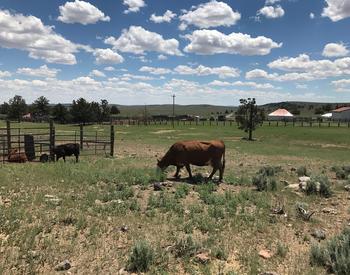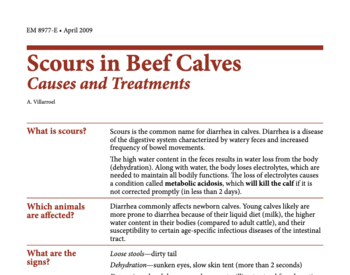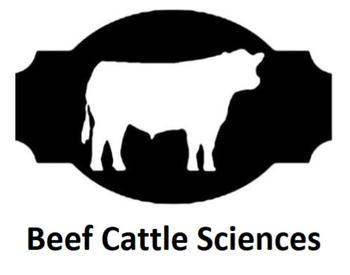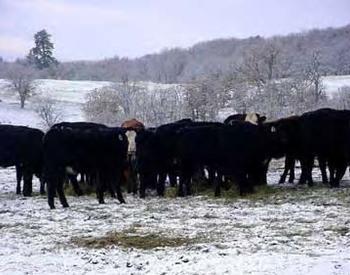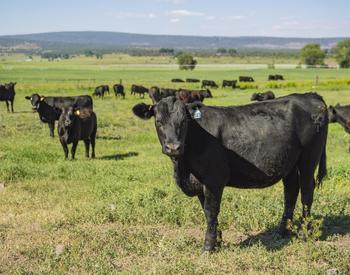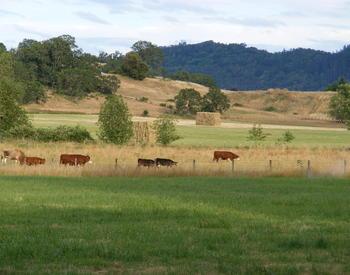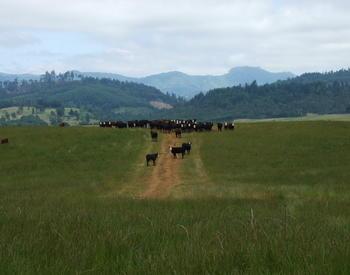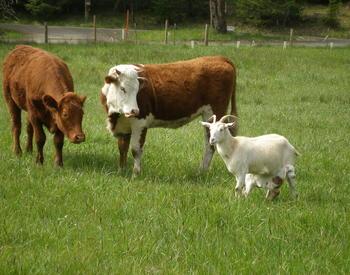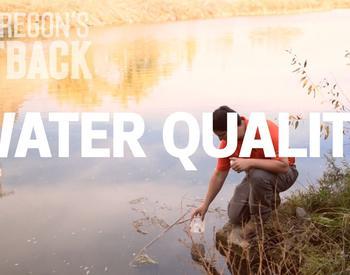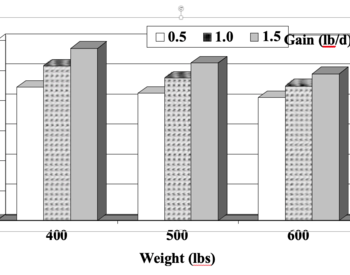Introduction
Monitoring body condition is a management tool for evaluating the nutritional status and energy reserves of beef cattle. Nutritional requirements of cattle must be met in order to attain an optimal level of performance and efficient use of feed resources. Proper feeding strategies and ration balancing techniques are discussed in the OSU — Beef Cattle Nutrition Workbook. By following these techniques and strategies, a producer can provide the proper nutrients required to maintain or improve body condition or nutrient reserves.
Cow body condition scoring (BCS) is a method of categorizing breeding animals by their degree of body nutrient reserves. Body condition scores put a quantitative score on a procedure many cow/calf producers have followed for years when determining the body fat reserves of their herds. Body condition scoring allows producers to be more exact in the description of their cows and provides a standardized tool for the beef industry to use when monitoring the energy reserves of the cowherd.
In addition, BCS allows producers to sort cows according to their nutritional needs, thereby improving the efficiency of their nutrition programs. There is a strong linkage between body condition and weight change. It may be advantageous to compare BCS to live weight. It has been reported that for every one BCS, you can expect a 75 to 95 lb change in weight, depending on the frame size of the cow. Body condition of a beef cow impacts reproductive performance, which may have a significant effect on profitability.
How to determine body condition score
Body condition scoring can be done by physically palpating individual cows, visually appraising each cow or scoring a representative sample of the herd. Palpation is likely more accurate but is not always practical due to large numbers of cattle or inadequate facilities. Once properly trained, a producer can visually inspect their cattle and accurately assign a BCS. However, care must be taken to adjust for fill and hair coat, particularly in cold climates. Body condition scores range from 1 (severely emaciated) to 9 (very obese). When visually inspecting cattle and assigning BCS, it is important to know where to look on the cow and what to look for (Figure 1).
Body condition scoring should be done when the animals have the same amount of rumen fill as the last time a BCS was assigned. Some producers prefer to assign BCS when the animals are shrunk (held off feed and water for 12 to 18 hours). This removes the rumen fill and makes it easier to see the ribs; thin cows with full rumens may appear to have more body condition than they actually do.
Description of body condition scores (adapted from Herd and Sprott, 1986):
- Emaciated: Bone structure of shoulders, ribs, back, hooks and pins sharp to the touch and easily visible. Little evidence of fat deposits or muscling.
- Very thin: Little evidence of fat deposits but some muscling in hindquarters. The spinous processes feel sharp to the touch and are easily seen, with space between them.
- Thin: Beginning of fat cover over the loin, back and foreribs. Backbone still highly visible. Processes of the spine can be identified individually by touch and may still be visible. Spaces between the processes are less pronounced.Borderline: Foreribs not noticeable; 12th and 13th ribs still noticeable to the eye, particularly in cattle with a big spring of rib and ribs wide apart. The transverse spinous processes can be identified only by palpation (with slight pressure) to feel rounded rather than sharp. Full but straightness of muscling in the hindquarters.
- Moderate: 12th and 13th ribs not visible to the eye unless animal has been shrunk. The transverse spinous processes can only be felt with firm pressure to feel rounded — not noticeable to the eye. Spaces between the processes not visible and only distinguishable with firm pressure. Areas on each side of the tail head are fairly well filled but not mounded.
- Good: Ribs fully covered, not noticeable to the eye. Hindquarters plump and full. Noticeable sponginess to covering of foreribs and on each side of the tail head. Firm pressure now required to feel transverse processes.
- Very good: Ends of the spinous processes can only be felt with very firm pressure. Spaces between processes can barely be distinguished at all. Abundant fat cover on either side of tail head with some patchiness evident.
- Fat: Animal taking on a smooth, blocky appearance; bone structure disappearing from sight. Fat cover thick and spongy with patchiness likely.
- Very fat: Bone structure not seen or easily felt. Tail head buried in fat. Animal's mobility may actually be impaired by excess amount of fat.
| Reference point | 1 | 2 | 3 | 4 | 5 | 6 | 7 | 8 | 9 |
|---|---|---|---|---|---|---|---|---|---|
| Physically weak | Yes | No | No | No | No | No | No | No | No |
| Muscle atrophy | Yes | Yes | Slight | No | No | No | No | No | No |
| Outline of spine visible | Yes | Yes | Yes | Slight | No | No | No | No | No |
| Outline of ribs visible | All | All | All | 3-5 | 1-2 | 0 | 0 | 0 | 0 |
| Outline of rib bones visible | Yes | Yes | Yes | Yes | Yes | Yes | Slight | No | No |
| Fat in brisket and flanks | No | No | No | No | No | Some | Full | Full | Extreme |
| Fat udder & patchy fat around tailhead | No | No | No | No | No | No | Slight | Yes | Extreme |
What is the ideal body condition score
The BCS of beef cows will vary depending on breed, environmental conditions, physiological conditions of your cattle and time of year. It is recommended that BCS of all cattle are taken and recorded at weaning and again at calving time. This gives a producer the ability to sort thin cows from more fleshy cows and strategically provide the thin cows with additional feed that will help them increase their body condition prior to calving and rebreeding.
It is recommended that mature cows enter the calving season at a BCS of at least 5 but not more than 7. First-calf, 2-year-old heifers are recommended to enter the calving season at a BCS of at least 6 but not more than 7. The reason for the higher recommendation for first-calf heifers is that they are still growing; consequently, they require more nutrients in order for them to continue to grow, produce milk and repair their reproductive tract for rebreeding. It is also recommended that producers breed heifers so that they will produce their first calf 30 days prior to the main herd. This gives heifers an additional 30 days to rebreed and stay in the herd.
The consequences and concerns of thin cows
In situations where feed is limiting, beef cows allocate nutrients according to a hierarchy of physiological functions. What does that really mean? Simply that when the cow doesn’t have enough nutrients in her diet to meet all her needs, her body has priorities as to how the limited nutrients will be used. Here is the list starting with highest priority:
- Maintenance.
- Lactation.
- Growth in young cows.
- Reproduction.
When a cow has inadequate feed and lacks the body reserves to draw on, reproduction is the first thing to suffer and the last to recover. Reproductive losses negatively impact ranch profitability.
Information collected from Texas producers involved in the Standardized Performance Analysis program (1991–1999) showed that the key measurement for reproductive and productive performance was pounds of calf weaned per exposed female. This number is a function of both conception rate and days from calving to conception (postpartum interval). Cows that calve early in the calving season will likely wean heavier calves. This emphasizes the importance of not only getting cattle bred but also getting them bred early in the breeding season.
Numerous researchers have shown that body condition may have a significant impact on pregnancy rate and postpartum interval. It has been reported that only 50% of cows having BCS of 4 were pregnant after a 90-day breeding season while 90% of those with BCS of 7 were settled (Table 2) in the same period. There may be a difference of 58 days in calving to conception between condition score 3 and 7 cows (Table 2).
Low BCS have significant impacts on calf health and growth. This obviously will also affect profits. Researchers have reported an increased calf death loss of 5% for thin cows (92% survival in thin cows compared to 97% for cows in good condition.) Furthermore, reduced gains of 0.25 pounds per day in calves from cows with a BCS of 3 as compared to those from cows with a BCS of 5 or greater (Table 2) has also been reported.
| BCS | Pregnancy rate (%) | Calving interval (days) | Calf average daily gain (lb) |
|---|---|---|---|
| 3 | 43 | 414 | 1.6 |
| 4 | 61 | 381 | 1.75 |
| 5 | 86 | 364 | 1.85 |
| 6 | 93 | 364 | 1.85 |
The cost of poor condition
Using an example herd of 100 cows we have calculated the cost of mismanagement in Table 3. In this example we will compare BCS 3 to 5.
This example is not all-inclusive but helps to show what some costs of thin cows may be. You would not expect to see an entire herd in this poor of condition. However, it is not uncommon to see a percentage of a herd with BCS 3; oftentimes these are old cows or two-year-olds weaning their first calf. So in reality you would (hopefully) not be losing the $141 per exposed cow but possibly a percentage of it. The ideal is to optimize production at minimum expense. This means you need to be able to put condition on the cows at the most efficient times and minimize condition loss when economically viable.
| Production outcomes | BCS 3 herd (100 bred cows) | BCS 5 herd (100 bred cows) |
|---|---|---|
| Cows exposed to produce 100 bred cows | 132 cows exposed 76% conception | 106 cows exposed 94% conception |
| Calf survival | 92 head of calves weaned (92%) | 97 head of calves weaned (97%) |
| Age at weaning; adjusted for postpartum interval (PPI) | Calves 180 days at weaning (88.5 days PPI) | Calves 210 days weaning (59.4 days PPI) |
| Calf weaning weight (using 85 lbs. avg. birth weight and adjusted weaning age) |
373 lbs Gain 1.6 lb/day |
474 lbs Gain 1.85 lb/ day |
| Pounds of weaned calf per herd | 34,316 total pounds | 45,978 total pounds |
| Value of calves at weaning | $105/cwt = $36,032 | $95/cwt = $43,679 |
| Income per cow calved | $360 | $437 |
| Income per cow exposed | $273 | $412 |
How and when to improve body condition score
It is evident that cows with decreased BCS will have lower production and produce less income. The producer must choose the most economically efficient management to adopt.
There may be cows with BCS ranging from 3 to 7 and adopting the same supplementation program for the entire group may not be an efficient management practice. Sorting cows into feeding groups may likely optimize the utilization of feed resources. Three groups are often recommended, yet in most operations, two groups would be more practical. If the cowherd is sorted into two groups, the first would likely include thin mature cows with BCS of 4 or less and 3-year-old and younger cows with BCS of 5 or less. This first group will be fed to gain condition. The remainder of the herd (those with an adequate BCS) should be fed a maintenance ration.
In order to optimize the utilization of the available feedstuff, it is important to match the requirement of nutrients according to the physiological stage of the cows, and the available feed resources. For example, in a spring calving herd, calves are weaned in late fall and the fetus in the pregnant cow is developing slowly. From a production sense, the fall is a practical time to consider increasing the body condition of the herd, yet this may be a time of limited quality feed.
Each operation will need to evaluate what will work best to maintain and add condition to the cowherd. It will be important to estimate the number of pounds to be gained in order to reach the desired condition score and formulate the ration accordingly.
There are no standard procedures to optimize production across different beef cattle operations; however, by making good decisions you can implement practices to improve your herd performance that will pay dividends for the time spent making decisions.
| Current BCS | Desired BCS | Approximate amount of body weight gain |
|---|---|---|
| 1 | 5 |
Needs to gain in excess of 350 pounds Economics are questionable |
| 2 | 5 |
Needs to gain 300 to 350 pounds Economics are questionable |
| 3 | 5 | Needs to gain 200 to 300 pounds |
| 4 | 5 | Needs to gain 150 to 200 pounds |
| 5 | 5-7 | Needs to gain weight of fetus (100 pounds) |
| 6 | 5-7 | Needs to gain weight of fetus (100 pounds) |
| 7 | 5-7 | No weight gain needed |
| 8 | 5-7 | Can probably lose from 50 to 150 pounds (during midpregnancy) |
| 9 | 5-7 | Can probably lose from 100 to 200 pounds (during midpregnancy) |
References
Herd, D. B., and L. R. Sprott. 1986. Texas Agric. Ext. Service B-1526. Texas A & M Univ., College Station.
Filley, et al. Beef Cattle Nutrition Workbook. December 2004. Oregon State University Extension Service, Corvallis, OR. 97331.
This document is part of the Oregon State University – Beef Cattle Library. Prior to acceptance, this document was anonymously reviewed by two experts in the area.
